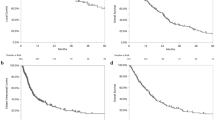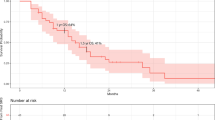Abstract
Purpose
Biological subtypes have been strongly correlated with loco-regional recurrence after definitive treatment for localized breast cancer. Brain metastases (BM) occur in 15% of patient diagnosed with breast cancer (BC). Therefore, we sought to determine whether biologic subtype is predictive of local control (LC) in BC patients with BM treated with stereotactic radiosurgery (SRS).
Methods
This is a single-center retrospective study conducted with Institutional Review Board approval for the period January 1, 2004–December 31, 2018. Eligibility criteria included (1) histopathologic proven BC with documented biologic subtype, (2) presence of BM treated with SRS (single fraction), (3) follow-up MRIs, and (4) clinical follow-up. Patients were subdivided into three biologic subtypes: ER+/HER2- (“luminal”), HER2+, and ER-/PR-/HER2 (TN). All patients were treated with LINAC-based SRS with dose according to published guidelines. Cox proportional hazard model and Kaplan-Meier were used for statistical analysis of LC and overall survival (OS).
Results
With a median follow-up of 11.1 months, 17 BC BM in 50 consecutive patients were included in this study. The median disease-specific GPA was 2.0, and all patients received systemic chemotherapy and/or hormonal therapy. The 12-month LC rates for the entire cohort were 85%, 87%, and 49% for luminal, HER2+, and TN, respectively, with a significantly shorter time to local failure for the TN subtype (p = 0.014). The 12-month OS rates were 83%, 88%, and 80% for luminal, HER2+, and TN, respectively, with a trend toward shorter OS in the TN group.
Conclusion
This study shows that in BC patients with BM treated with SRS, biologic subtype affects LC. Consideration of radiation treatment intensification or altered fractionation to improve LC may be indicated for the TN subtype. Further multicenter studies are necessary to corroborate our results.


Similar content being viewed by others
References
Johnson JD, Young B (1996) Demographics of brain metastasis. Neurosurg Clin N Am 7(3):337–344
Wen PY, Loeffler JS (1999) Management of brain metastases. Oncology 13(7):941–954 57–61; discussion 61–2, 9
Posner JB (1992) Management of brain metastases. Rev Neurol 148(6–7):477–487
Paterson AH, Agarwal M, Lees A, Hanson J, Szafran O (1982) Brain metastases in breast cancer patients receiving adjuvant chemotherapy. Cancer 49(4):651–654
Sundermeyer ML, Meropol NJ, Rogatko A, Wang H, Cohen SJ (2005) Changing patterns of bone and brain metastases in patients with colorectal cancer. Clin Colorectal Cancer 5(2):108–113
Barnholtz-Sloan JS, Sloan AE, Davis FG, Vigneau FD, Lai P, Sawaya RE (2004) Incidence proportions of brain metastases in patients diagnosed (1973 to 2001) in the Metropolitan Detroit Cancer Surveillance System. J Clin Oncol 22(14):2865–2872
Lin NU, Bellon JR, Winer EP (2004) CNS metastases in breast cancer. J Clin Oncol 22(17):3608–3617
Schouten LJ, Rutten J, Huveneers HA, Twijnstra A (2002) Incidence of brain metastases in a cohort of patients with carcinoma of the breast, colon, kidney, and lung and melanoma. Cancer 94(10):2698–2705
Horton JK, Jagsi R, Woodward WA, Ho A (2018) Breast cancer biology: clinical implications for breast radiation therapy. Int J Radiat Oncol Biol Phys 100(1):23–37
Howlader N, Altekruse SF, Li CI et al (2014) US incidence of breast cancer subtypes defined by joint hormone receptor and HER2 status. Jnci-J Natl Cancer I 106(5)
Jensen EV, Jordan VC (2003) The estrogen receptor: a model for molecular medicine. Clin Cancer Res 9(6):1980–1989
Perou CM, Sorlie T, Eisen MB et al (2000) Molecular portraits of human breast tumours. Nature 406(6797):747–752
Breast Cancer Staging System (2018) AJCC cancer staging manual, Eight Edition
Arvold ND, Oh KS, Niemierko A, Taghian AG, Lin NU, Abi-Raad RF, Sreedhara M, Harris JR, Alexander BM (2012) Brain metastases after breast-conserving therapy and systemic therapy: incidence and characteristics by biologic subtype. Breast Cancer Res Treat 136(1):153–160
Millar EK, Graham PH, O'Toole SA et al (2009) Prediction of local recurrence, distant metastases, and death after breast-conserving therapy in early-stage invasive breast cancer using a five-biomarker panel. J Clin Oncol 27(28):4701–4708
Wang YH, Yin QG, Yu Q, Zhang J, Liu Z, Wang S, Lv S, Niu Y (2011) A retrospective study of breast cancer subtypes: the risk of relapse and the relations with treatments. Breast Cancer Res Treat 130(2):489–498
Merino T, Ip T, Dominguez F et al (2018) Risk factors for loco-regional recurrence in breast cancer patients: a retrospective study. Oncotarget 9(54):30355–30362
Langlands FE, Horgan K, Dodwell DD, Smith L (2013) Breast cancer subtypes: response to radiotherapy and potential radiosensitisation. Brit J Radiol 86(1023)
Miller JA, Kotecha R, Ahluwalia MS, Mohammadi AM, Chao ST, Barnett GH, Murphy ES, Vogelbaum MA, Angelov L, Peereboom DM, Suh JH (2017) Overall survival and the response to radiotherapy among molecular subtypes of breast cancer brain metastases treated with targeted therapies. Cancer 123(12):2283–2293
Buatti JM, Friedman WA, Meeks SL, Bova FJ (2000) RTOG 90-05: the real conclusion. Int J Radiat Oncol Biol Phys 47(2):269–271
Tsao MN, Rades D, Wirth A, Lo SS, Danielson BL, Gaspar LE, Sperduto PW, Vogelbaum MA, Radawski JD, Wang JZ, Gillin MT, Mohideen N, Hahn CA, Chang EL (2012) Radiotherapeutic and surgical management for newly diagnosed brain metastasis(es): an American Society for Radiation Oncology evidence-based guideline. Pract Radiat Oncol 2(3):210–225
Lee EW, Wei LJ, Amato DA, Leurgans S (1992) Cox-type regression-analysis for large numbers of small-groups of correlated failure time observations. Nato Adv Sci I E-App 211:237–247
Shtatland ES, Barton MB (1998) An information-gain measure of fit in PROC LOGISTIC. In: Proceedings of the Twenty-Third Annual Sas Users Group International Conference. pp 1195–9
DiStefano A, Yong Yap Y, Hortobagyi GN, Blumenschein GR (1979) The natural history of breast cancer patients with brain metastases. Cancer 44(5):1913–1918
Park IH, Ro J, Lee KS, Nam BH, Kwon Y, Shin KH (2009) Trastuzumab treatment beyond brain progression in HER2-positive metastatic breast cancer. Anna Oncol 20(1):56–62
Park YH, Park MJ, Ji SH, Yi SY, Lim DH, Nam DH, Lee JI, Park W, Choi DH, Huh SJ, Ahn JS, Kang WK, Park K, Im YH (2009) Trastuzumab treatment improves brain metastasis outcomes through control and durable prolongation of systemic extracranial disease in HER2-overexpressing breast cancer patients. Br J Cancer 100(6):894–900
Dawood S, Broglio K, Esteva FJ, Ibrahim NK, Kau SW, Islam R, Aldape KD, Yu TK, Hortobagyi GN, Gonzalez-Angulo AM (2008) Defining prognosis for women with breast cancer and CNS metastases by HER2 status. Ann Oncol 19(7):1242–1248
Martin AM, Cagney DN, Catalano PJ, Warren LE, Bellon JR, Punglia RS, Claus EB, Lee EQ, Wen PY, Haas-Kogan DA, Alexander BM, Lin NU, Aizer AA (2017) Brain metastases in newly diagnosed breast Cancer: a population-based study. JAMA Oncol 3(8):1069–1077
Bastos DCA, Maldaun MVC, Sawaya R et al (2018) Biological subtypes and survival outcomes in breast cancer patients with brain metastases in the targeted therapy era. Neuro-Oncol Pract 5(3):161–169
Suzuki S, Inoue T, Ishido K (2016) Factors influencing local tumor control after gamma knife radiosurgery for intracranial metastases from breast cancer. J Clin Neurosci 33:154–158
Dyer MA, Kelly PJ, Chen YH, Pinnell NE, Claus EB, Lee EQ, Weiss SE, Arvold ND, Lin NU, Alexander BM (2012) Importance of extracranial disease status and tumor subtype for patients undergoing radiosurgery for breast cancer brain metastases. Int J Radiat Oncol 83(4):E479–EE86
Wen Y, Dai G, Wang L, Fu K, Zuo S (2019) Silencing of XRCC4 increases radiosensitivity of triple-negative breast cancer cells. Biosci Rep 39(3)
Minniti G, Scaringi C, Paolini S, Lanzetta G, Romano A, Cicone F, Osti M, Enrici RM, Esposito V (2016) Single-fraction versus multifraction (3 x 9 Gy) stereotactic radiosurgery for large ( > 2 cm) brain metastases: a comparative analysis of local control and risk of radiation-induced brain necrosis. Int J Radiat Oncol 95(4):1142–1148
Lin NU, Lee EQ, Aoyama H, Barani IJ, Barboriak DP, Baumert BG, Bendszus M, Brown PD, Camidge DR, Chang SM, Dancey J, de Vries EG, Gaspar LE, Harris GJ, Hodi FS, Kalkanis SN, Linskey ME, Macdonald DR, Margolin K, Mehta MP, Schiff D, Soffietti R, Suh JH, van den Bent M, Vogelbaum MA, Wen PY, Response Assessment in Neuro-Oncology (RANO) group (2015) Response assessment criteria for brain metastases: proposal from the RANO group. Lancet Oncol 16(6):E270–E2E8
Author information
Authors and Affiliations
Corresponding author
Ethics declarations
Conflict of interest
Lucas Resende Salgado declares that he has no conflict of interest. Andrew W. Smith declares that he has no conflict of interest. Anthony Nehlsen declares that he has no conflict of interest. Alexandra Cohen declares that she has no conflict of interest. Tzu-Chi Tseng declares that she has no conflict of interest. Jung-Yi Lin declares that she has no conflict of interest. Erin Moshier declares that she has no conflict of interest. Michael Buckstein declares that he has no conflict of interest. Richard Bakst declares that he has no conflict of interest. Isabelle M. Germano is a Brainlab and Integra consultant, Surgical Theater, and Elminda stockholder. Sheryl Green declares that she has no conflict of interest.
Research involving human participants and/or animals
This article does not contain any studies with human participants or animals performed by any of the authors.
Informed consent
Informed consent was obtained from all individual participants included in the study.
Additional information
Publisher’s note
Springer Nature remains neutral with regard to jurisdictional claims in published maps and institutional affiliations.
Rights and permissions
About this article
Cite this article
Resende Salgado, L., Smith, A.W., Nehlsen, A. et al. Biologic subtypes as a predictor of local control in patients with brain metastases from breast cancer after stereotactic radiosurgery. J Radiat Oncol 9, 67–73 (2020). https://doi.org/10.1007/s13566-020-00424-0
Received:
Accepted:
Published:
Issue Date:
DOI: https://doi.org/10.1007/s13566-020-00424-0




